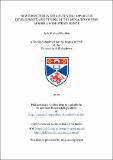Files in this item
New frontiers in strain-tuning : apparatus development, and tuning of the nemacity of FeSe across a wide strain range
Item metadata
| dc.contributor.advisor | Mackenzie, Andrew | |
| dc.contributor.author | Bartlett, Jack Michael | |
| dc.coverage.spatial | xix, 208 p. | en_US |
| dc.date.accessioned | 2019-12-03T15:49:48Z | |
| dc.date.available | 2019-12-03T15:49:48Z | |
| dc.date.issued | 2019-06-24 | |
| dc.identifier.uri | https://hdl.handle.net/10023/19058 | |
| dc.description.abstract | Over the last decade, an ‘iron age’ of superconductivity has challenged the paradigm of unconventional pairing established by copper-oxide-based materials. Fascinatingly, in these iron-based compounds superconductivity emerges from a state in which electrons choose to distinguish between two equivalent directions of the underlying crystalline axes. The origin of this ‘nematic’ state is highly debated. This thesis concentrates on FeSe, a material appealing because its nematicity does not occur in proximity to long-range magnetic order. Although uniaxial strain couples to nematic order, experiments to date have focused on applying only a small symmetry-breaking strain. The mechanical properties of FeSe make utilising established piezoelectric-based apparatus, designed for continuous tuning of large uniaxial strains, challenging. In this thesis we develop a platform to which samples can be adhered, and apply large anisotropic strain to FeSe. When of the same symmetry as the nematicity, and larger than the structural distortion, this applied strain fully constrains the lattice. We provide a precise set of resistivity measurements across a wide temperature and strain range, revealing vital new phenomenologies. We establish the relationship between electrical transport and nematicity across a large strain range at the structural transition and, by isolating the influence of domain walls, characterise the elastoresistivity for temperatures below this transition. By tracking the onset of domain formation, we determine the temperature dependence of the spontaneous structural distortion, and use this to extract the intrinsic resistivity anisotropy within a single nematic domain. Interestingly, we discover a crossover at ~ 50 K between distinct high- and low-temperature behaviours. This thesis is also concerned with the development of apparatus for tuning strain. We conceptualise a new type of stress-controlled cell, which can apply large (up to 8 GPa in compression) uniaxial stresses to microstructured samples – pushing them to their ultimate mechanical limit. | en_US |
| dc.description.sponsorship | "This work was supported by the EPSRC Research Council via the Scottish Doctoral Training Centre in Condensed Matter Physics (under grant number EP/L015110/1), as well as the Max Planck Gesellschaft." -- Acknowledgements | en |
| dc.language.iso | en | en_US |
| dc.publisher | University of St Andrews | |
| dc.relation | New frontiers in strain-tuning : apparatus development, and tuning of the nematicity of FeSe across a wide strain range (Thesis data) Bartlett, J.M., University of St Andrews. DOI: https://doi.org/10.17630/2c041fd5-37cb-4225-bb4e-0b75d4231d21 | en |
| dc.relation.uri | https://doi.org/10.17630/2c041fd5-37cb-4225-bb4e-0b75d4231d21 | |
| dc.subject.lcc | QC611.98H54B2 | |
| dc.subject.lcsh | Iron-based superconductors | en |
| dc.subject.lcsh | Strains and stresses | en |
| dc.title | New frontiers in strain-tuning : apparatus development, and tuning of the nemacity of FeSe across a wide strain range | en_US |
| dc.type | Thesis | en_US |
| dc.contributor.sponsor | Engineering and Physical Sciences Research Council (EPSRC) | en_US |
| dc.contributor.sponsor | Scottish Doctoral Training Centre in Condensed Matter Physics (CM-CDT) | en_US |
| dc.contributor.sponsor | Max-Planck-Gesellschaft zur Förderung der Wissenschaften | en_US |
| dc.type.qualificationlevel | Doctoral | en_US |
| dc.type.qualificationname | PhD Doctor of Philosophy | en_US |
| dc.publisher.institution | The University of St Andrews | en_US |
| dc.identifier.doi | https://doi.org/10.17630/10023-19058 |
This item appears in the following Collection(s)
Items in the St Andrews Research Repository are protected by copyright, with all rights reserved, unless otherwise indicated.

